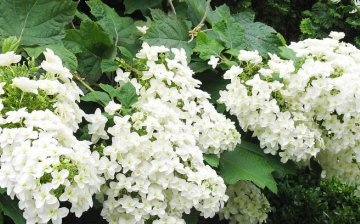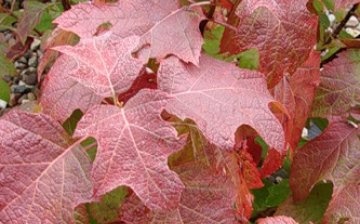Oak-leaved hydrangea - the basics of care and cultivation
I would not say that oakleaf hydrangea foliage is completely like an oak. But there is a certain similarity in the shape and cut of the leaves. But in oak, the edges of the leaves are smoothed and rounded, and in hydrangea, on the contrary, they are pointed.
The oak-leaved hydrangea is not as famous and widespread in the gardens of our strip as its sister, the panicle hydrangea. The latter can be easily recognized among other plants by the lush bushes and the abundant flowering of delicate flowers of various colors: from white and pink to purple and green.
What does oakleaf hydrangea look like?
This plant is a rather large shrub, reaching a height of two meters. The leaves are very textured, rough to the touch, reminiscent of the shape of oak leaves, however, their edges are sharp, carved.
In the summer months, the foliage on this variety of hydrangea is green, and with the onset of autumn it becomes crimson, which looks very impressive and decorative and decorates the garden.
Oak-leaved hydrangea blooms for a very long time: from summer to autumn! Flowers of white color, collected in cone-shaped inflorescences.
Oak-leaved hydrangeas are frost-resistant plants, therefore they tolerate the winters of central Russia very well.
Planting hydrangeas
When planting in a permanent place in the garden, it is better to choose those areas that are not located in direct sunlight. It is better to give preference to partial shade or even shadow. At the same time, such conditions are not reflected in flowering.
As for the soil, the best option would be loams, moisture-permeable soils, since the hydrangea is a moisture-loving plant. It will be very useful to add organic fertilizers to the soil for planting.
If the soil is alkaline with a pH of 7 or more, it will be necessary to acidify it or not plant the hydrangea in such soil at all. The optimal pH level for oaky hydrangea is 4.5-6.5.
Soil moisture requirements
Hydrangea loves moisture, so there is no need to let the soil dry out. It is necessary that the earth is always moist. In this case, mulching the soil where the hydrangea grows will be very useful, at least once a year. For this, shavings, wood chips, needles, leaf humus or even tree bark are used.
Wintering of young plants
In general, oak-leaved hydrangea is resistant to cold weather. However, in the first year of life, it is better to transplant the plant into a pot for the winter and grow it until spring as a houseplant.
In autumn, the leaves on the hydrangea become burgundy, gradually falling off. This happens around the beginning of December. When the leaves have fallen off, the plant enters a dormant state. Therefore, you can move it from bright light to the back of the room and significantly reduce watering.
Around mid-April, you can see that the hydrangea has woken up, buds are starting to get under way. Then you can already put the pot with the plant on the windowsill, where there is sufficient lighting for growth.
You can water the awakened plant with the addition of fertilizers to awaken the side shoots and accelerate the growth of leaves.
In May, it will already be possible to plant the hydrangea back in the garden, in its original place.
Hydrangea bloom
Usually in the second year of growth, hydrangeas develop faster and more noticeably than in the first year of life. After landing in a permanent place in May, in the first decade of July, you can already wait for the first flowering.
Usually, the flowers of oak-leaved hydrangeas are white, somewhat reminiscent of viburnum flowers with yellow fluffy stamens. Flowers have a pleasant aroma, which bumblebees, butterflies and bees willingly flock to.
Decorative properties
Oak-leaved hydrangea can become an all-season decoration of your garden! Indeed, in the summer and until the fall, it pleases with lush and fragrant inflorescences, and in the fall, dressed in crimson-burgundy foliage, which does not fall off for a very long time, also does not lose its attractiveness at all.
Outdoor wintering
If you leave the hydrangea to winter in the open air, then it is recommended to cover the bush with earth higher to protect the root system from frost.
To prevent the branches from breaking from the caps of snow, they will need to be tied to a support. Then you can cover the hydrangea bushes with dry leaves, branches, forming something like a hut around the plant.
Hydrangea pests and diseases
Of the main pests that can infect hydrangeas, the following insects are distinguished:
- aphid;
- weevil;
- spider mite;
- sharp-nosed.
Of the diseases, oakleaf hydrangea bushes can be affected by gray rot, downy mildew, various fungal diseases, resulting in the appearance of spots on the leaves.
How to propagate hydrangea
Mainly for reproduction in spring and summer, they use the apical parts of the shoots, which are not yet covered with dense bark. Plants can be propagated by woody cuttings, but this is done in the cold season.






